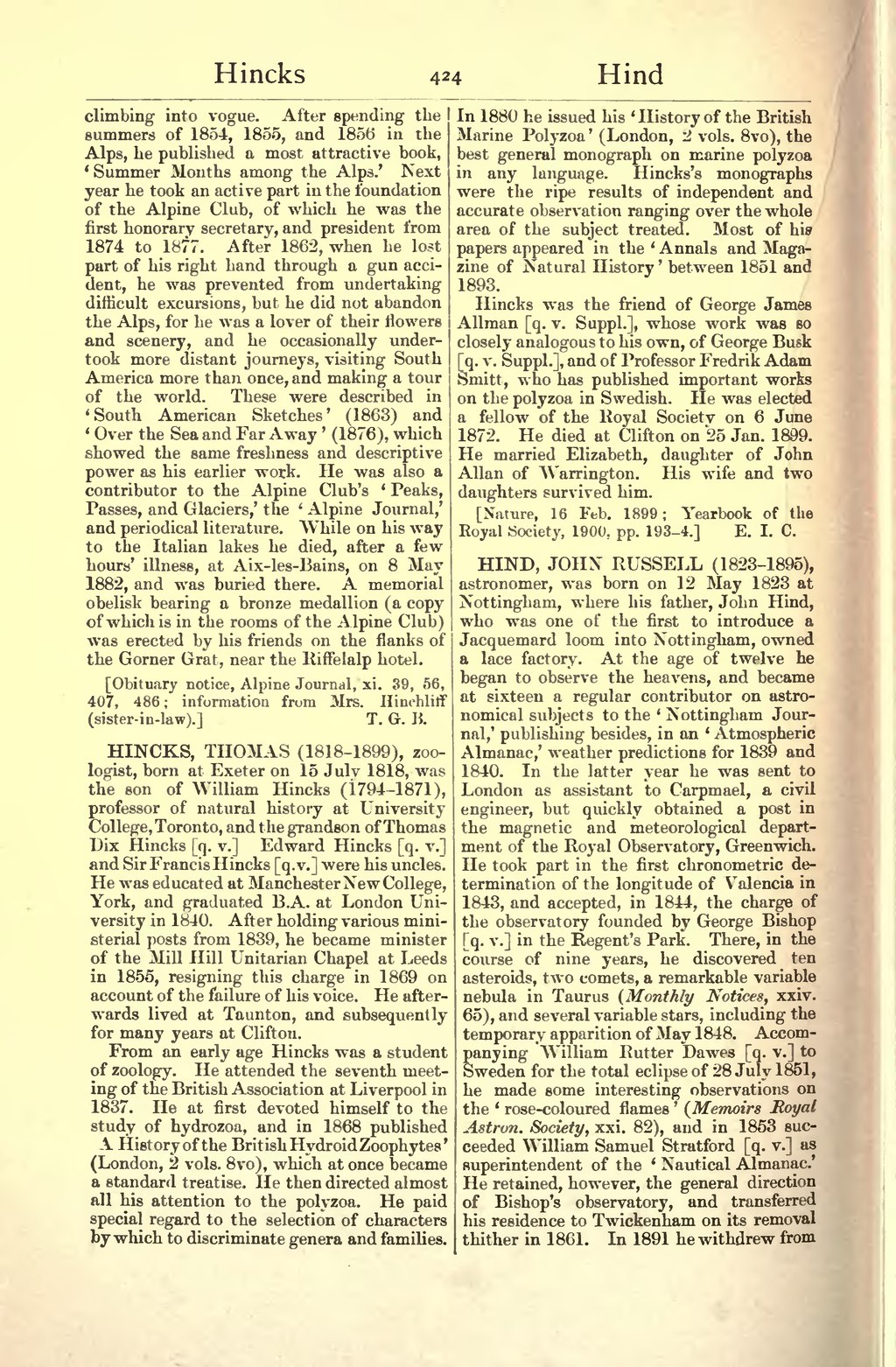climbing into vogue. After spending the summers of 1854, 1855, and 1856 in the Alps, he published a most attractive book, 'Summer Months among the Alps.' Next year he took an active part in the foundation of the Alpine Club, of which he was the first honorary secretary, and president from 1874 to 1877. After 1862, when he lost part of his right hand through a gun accident, he was prevented from undertaking difficult excursions, but he did not abandon the Alps, for he was a lover of their flowers and scenery, and he occasionally undertook more distant journeys, visiting South America more than once, and making a tour of the world. These were described in 'South American Sketches' (1863) and 'Over the Sea and Far Away' (1876), which showed the same freshness and descriptive power as his earlier work. He was also a contributor to the Alpine Club's 'Peaks, Passes, and Glaciers,' the 'Alpine Journal,' and periodical literature. While on his way to the Italian lakes he died, after a few hours' illness, at Aix-les-Bains, on 8 May 1882, and was buried there. A memorial obelisk bearing a bronze medallion (a copy of which is in the rooms of the Alpine Club) was erected by his friends on the flanks of the Gorner Grat, near the Riffelalp hotel.
[Obituary notice, Alpine Journal, xi. 39, 56, 407, 486; information from Mrs. Hinchliff (sister-in-law).]
HINCKS, THOMAS (1818–1899), zoologist, born at Exeter on 15 July 1818, was the son of William Hincks (1794-1871), professor of natural history at University College, Toronto, and the grandson of Thomas Dix Hincks [q. v.] Edward Hincks [q. v.] and Sir Francis Hincks [q. v.] were his uncles. He was educated at Manchester New College, York, and graduated B.A. at London University in 1840. After holding various ministerial posts from 1839, he became minister of the Mill Hill Unitarian Chapel at Leeds in 1855, resigning this charge in 1869 on account of the failure of his voice. He afterwards lived at Taunton, and subsequently for many years at Clifton.
From an early age Hincks was a student of zoology. He attended the seventh meeting of the British Association at Liverpool in 1837. He at first devoted himself to the study of hydrozoa, and in 1868 published A History of the British Hydroid Zoophytes' (London, 2 vols. 8vo), which at once became a standard treatise. He then directed almost all his attention to the polyzoa. He paid special regard to the selection of characters by which to discriminate genera and families.
In 1880 he issued his 'History of the British Marine Polyzoa' (London, 2 vols. 8vo), the best general monograph on marine polyzoa in any language. Hincks's monographs were the ripe results of independent and accurate observation ranging over the whole area of the subject treated. Most of his papers appeared in the 'Annals and Magazine of Natural History ' between 1851 and 1893.
Hincks was the friend of George James Allman [q. v. Suppl.], whose work was so closely analogous to his own, of George Busk [q. v. Suppl.], and of Professor Fredrik Adam Smitt, who has published important works on the polyzoa in Swedish. He was elected a fellow of the Royal Society on 6 June 1872. He died at Clifton on 25 Jan. 1899. He married Elizabeth, daughter of John Allan of Warrington. His wife and two daughters survived him.
[Nature, 16 Feb. 1899; Yearbook of the Royal Society, 1900. pp. 193-4.]
HIND, JOHN RUSSELL (1823–1895), astronomer, was born on 12 May 1823 at Nottingham, where his father, John Hind, who was one of the first to introduce a Jacquemard loom into Nottingham, owned a lace factory. At the age of twelve he began to observe the heavens, and became at sixteen a regular contributor on astronomical subjects to the 'Nottingham Journal,' publishing besides, in an 'Atmospheric Almanac,' weather predictions for 1839 and 1840. In the latter year he was sent to London as assistant to Carpmael, a civil engineer, but quickly obtained a post in the magnetic and meteorological department of the Royal Observatory, Greenwich. He took part in the first chronometric determination of the longitude of Valencia in 1843, and accepted, in 1844, the charge of the observatory founded by George Bishop [q. v.] in the Regent's Park. There, in the course of nine years, he discovered ten asteroids, two comets, a remarkable variable nebula in Taurus (Monthly Notices, xxiv. 65), and several variable stars, including the temporary apparition of May 1848. Accompanying William Rutter Dawes [q. v.] to Sweden for the total eclipse of 28 July 1851, he made some interesting observations on the 'rose-coloured flames' (Memoirs Royal Astron. Society, xxi. 82), and in 1853 succeeded William Samuel Stratford [q. v.] as superintendent of the 'Nautical Almanac.' He retained, however, the general direction of Bishop's observatory, and transferred his residence to Twickenham on its removal thither in 1861. In 1891 he withdrew from
